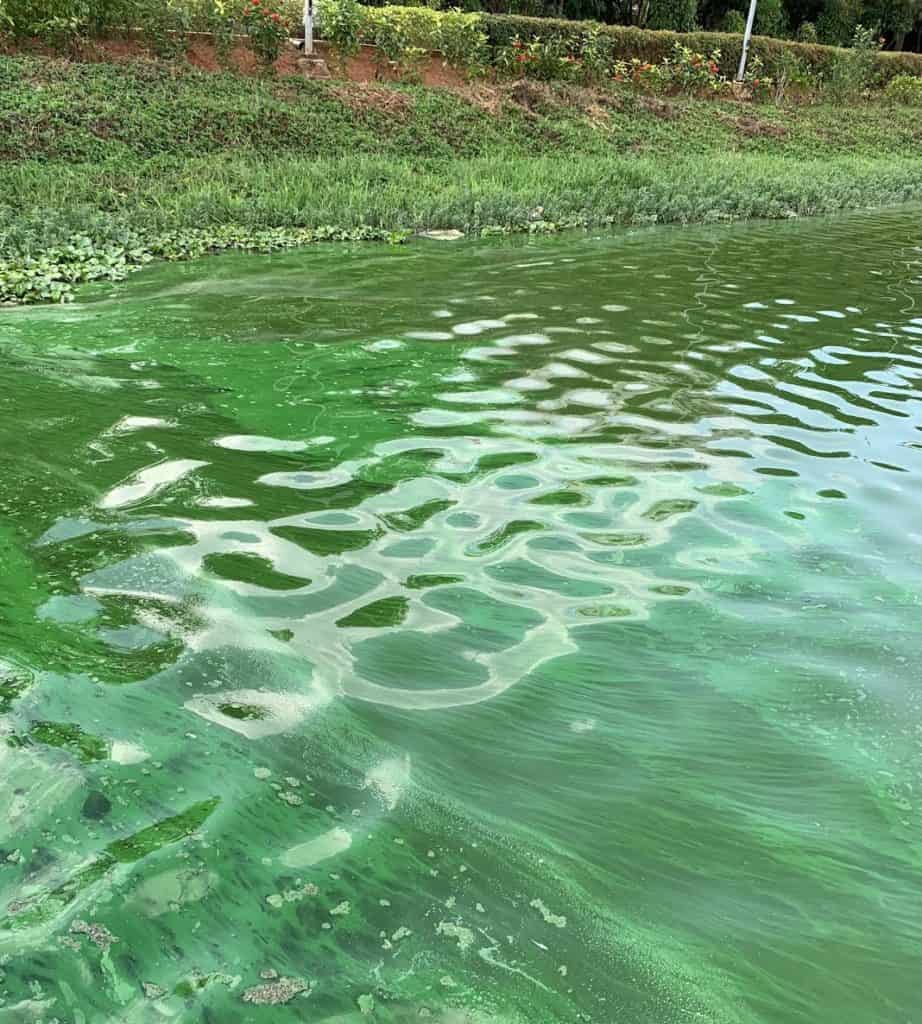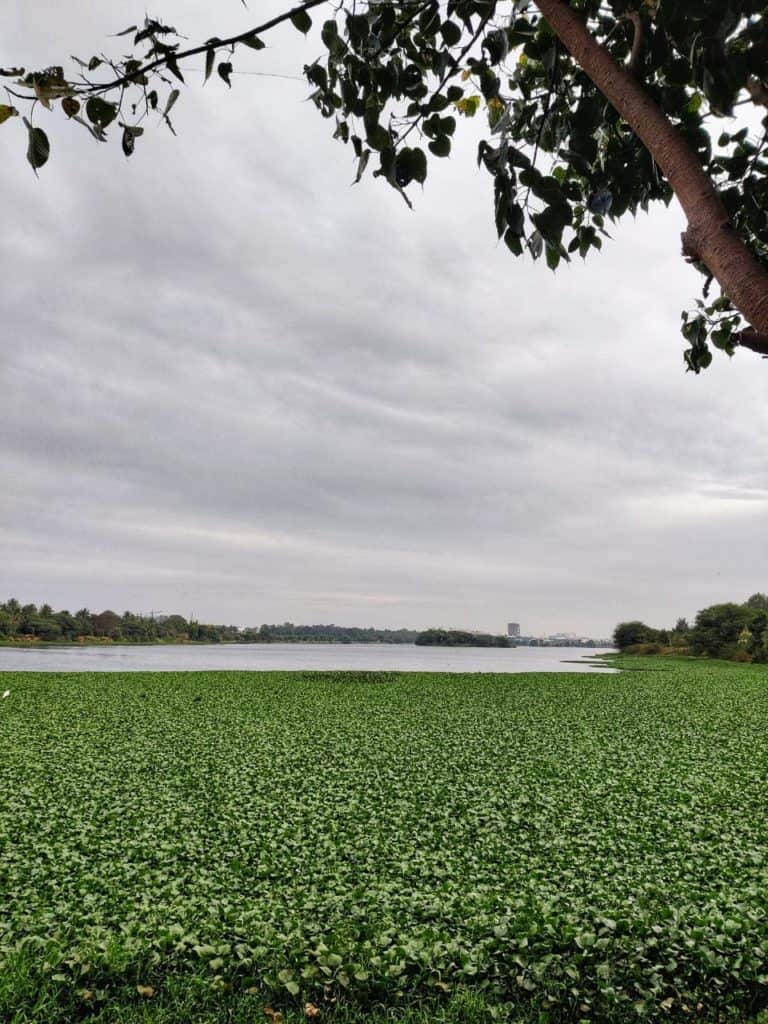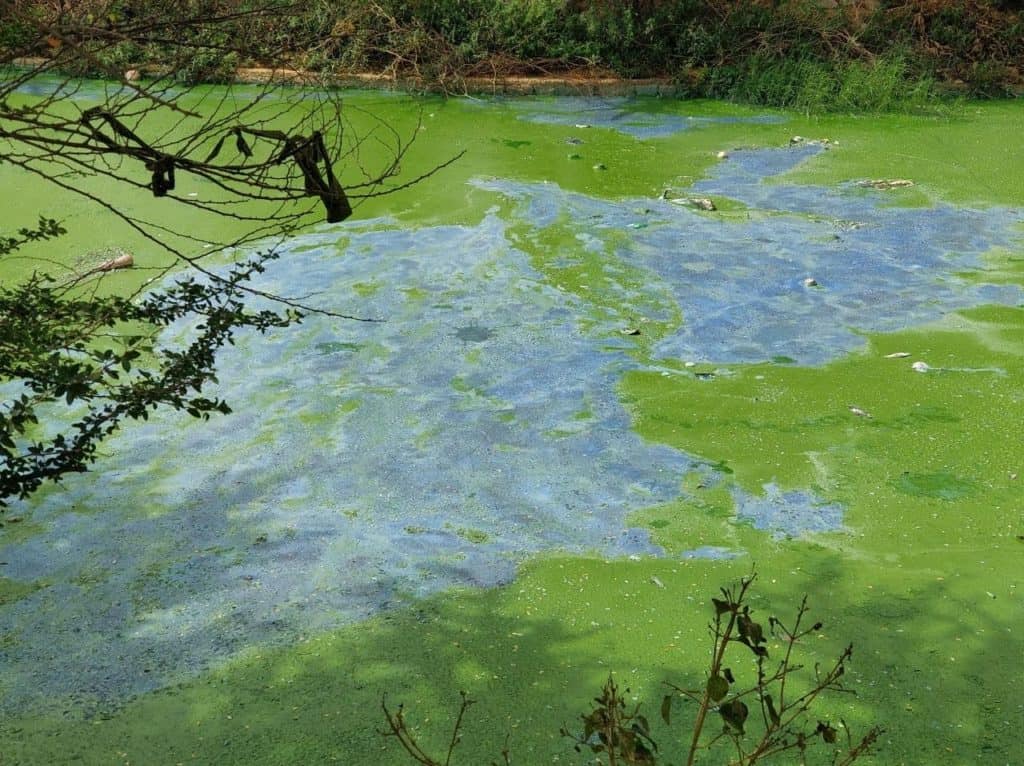One of the characteristic features of a lake is its colour.
You may have noticed that the water in many lakes in Bengaluru is green, and not blue, as you might have imagined it to be. This is due to the presence of algae. Algae are microscopic plants that contain chlorophyll which is the pigment that gives it a green colour. While some amount of algae is healthy for the lake ecosystem, excess algae can be harmful and is an indicator of a polluted and nutrient-rich lake.
Lakes rich in nutrients such as nitrogen and phosphorus are called eutrophic lakes, and the nutrient enrichment of lakes is called eutrophication. Apart from causing algal blooms, eutrophication can also lead to blooms of cyanobacteria (photosynthetic bacteria) and overgrowth of floating aquatic weeds, such as water hyacinth.
Cyanobacterial blooms can be harmful to animal and human health as they produce potent toxins that can lead to the deaths of fish, birds and other animals. Floating weeds, when not controlled, can block sunlight from entering the lake and lead to a reduction in the amount of oxygen present for the aquatic life to survive.
In this article, we address why eutrophication occurs and what can be done to prevent it.
System Map

A lake rich in nutrients is known as an eutrophic lake, and in Bengaluru, this mostly happens due to the discharge of industrial effluents, runoff and untreated/treated sewage.
- Industrial effluents, especially from paper and pulp, dye, dairy and food processing units, are rich in organic matter and can have higher concentrations of nutrients, hence the direct inflow of these materials boosts the growth of algal blooms exponentially. The effluents enter the water body mainly because of inefficient or unavailable treatment systems and poor enforcement by the monitoring authorities.
- Runoff generated during rainfall often carries nutrients from soil and roads into the water bodies. In peri-urban and rural areas, the runoff into lakes consists of excess fertilisers.
- Raw and untreated sewage consists of a large amount of nutrients, mainly Nitrogen and Phosphorus. Nitrogen compounds like nitrates and ammonia come from animal waste and sewage, whereas phosphorus in the form of phosphates come from detergents and domestic sewage. Standard sewage treatment plants still produce effluents with large amounts of nutrients, so a final stage nutrient removal process should be an essential part of large sewage treatment plants in urban environments. This final nutrient removal treatment can be delivered through a nature-based solution, such as a well-designed constructed wetland.
- Raw sewage also enters the lakes through storm-water drains because of the lack of an underground drainage network in many parts of the city.
- There is some sewage that enters the lakes from the base-flow from unlined septic tanks, soak pits and grey-water streams from small settlements around the lake.
- Improperly designed channels cause stagnation of water, which in turn create less turbulent areas ideal for algal growth. This was observed in Rachenahalli lake where there was a thick layer of algae in the stagnant outlet, while there were no algal bloom in the flowing outlet.
- Climate is also one of the major factors responsible for the rapid growth of algal blooms as sunlight and warm temperature aid the growth of algae. Given Bengaluru’s moderate climate year-round, it supports the growth of algae in nutrient-rich water.
Eutrophication impact: Excessive plant growth

Untreated and treated sewage is rich in nutrients, especially nitrogen, in the form of ammonium nitrate. Floating aquatic plants, like the invasive water hyacinth, prefer nitrogen in this form and, therefore, grow abundantly in water bodies with nutrient pollution.
Free-floating plants like hyacinth breed rampantly and often cover an entire lake surface, preventing sunlight from reaching below the water surface. This reduces oxygen production by submerged plants and algae, with lower dissolved oxygen concentrations affecting fish in the lake.

Reduced growth of submerged plants and phytoplankton ultimately impacts the entire aquatic ecosystem, including fish and wetland birds that rely on this primary production.
Algal Blooms
Algal blooms are dense growth of algae, photosynthetic organisms, on the water surface which occur mostly in nutrient rich lakes. Algal blooms cause major daily fluctuations in the oxygen levels in the lake. They produce oxygen throughout the day due to photosynthesis and consume dissolved oxygen during the night, creating low oxygen conditions that can cause severe stress to fishes in the lake. This high variability of dissolved oxygen in eutrophic lakes is one of the reasons for fish kill.
Cyanobacterial growth
Cyanobacteria, also commonly known as blue-green algae, are a type of bacteria that contain chlorophyll, like plants, and so have similar properties to algae. Cyanobacteria grow abundantly in nutrient-rich water, particularly with enrichment of phosphorus, such as lakes receiving treated sewage effluent. Cyanobacterial blooms can become really thick and block sunlight from entering the lake, thereby reducing the amount of oxygen animals and plants underwater can receive. Certain types of cyanobacteria may produce toxins- the cyanotoxins are classified depending on the type of reaction they cause such as hepatotoxins affect the liver, neurotoxins affect the nervous system and derma toxins affect the skin. In humans it can cause a range of health effects such as skin rashes, headaches and fever, to more severe issues such as liver and nerve damage when cyanobacteria contaminated water is consumed. Common types of bloom-forming cyanobacteria found in freshwater are Microcystis, Dolichospermum and Cylindrospermopsis.
The story of Bellandur and Jakkur lakes
For decades, water hyacinth has infested Bellandur lake, covering approximately 60% of the lake’s surface. Contrary to this, Jakkur lake since the time it was restored (2008), never reported water hyacinth infestation issues; only recently, large quantities of raw sewage entered the lake and led to hyacinth growth.
Throughout the year, Jakkur lake water is green in colour, reflecting uncontrolled growth of harmful algae also called harmful algal blooms (HABs). Given the presence of nutrients/pollutants in both the lakes, the interesting question is about what causes the prevalence of water hyacinth vs HABs in polluted vs restored lakes.
Since 2017, the Water and Soil Lab at ATREE has been monitoring both the lakes in Bengaluru.
The monthly and seasonal data shows very high average Ammonium-N levels in Bellandur lake (40 mg/l) as compared to Jakkur lake (5 mg/l).
Several studies indicate that plants require less energy for absorption and uptake of Ammonium-N than Nitrate-N and thus have been reported to proliferate in the presence of Ammonium-N. Cyanobacteria grow on both nitrogen sources (Nitrates and Ammonium-N), with faster growths recorded in the presence of Ammonium-N.

The competition for the nitrogen source pushes water hyacinths to compete with algae – overcoming and proliferating in Ammonium-N rich water bodies. The fast growth rate allows water hyacinth to quickly shade the water preventing HABs, while at the same time absorbing huge amounts of nutrients from the water.
As a result, lakes receiving raw sewage, such as Bellandur, report widespread water hyacinth growth compared to Jakkur lake with HAB issues.
Here’s how lake managers and citizens can play an important role in the management of lakes in our city.
What lake managers should do
- As mentioned in our previous articles, the primary goal should be to stop the discharge of raw sewage, industrial effluents and solid waste into lakes. To do that the potential point sources of nutrient pollution need to be identified and mapped.
- Increase treatment of raw sewage before it flows into lakes. One step that can be taken is to have a nutrient removal stage (secondary treatment) at the sewage treatment plant (STP).
- Another way to reduce nutrient entry into the lake is to create wetlands, they act as a buffer zone by absorbing some of the excess nutrients before it enters the lake.
- Address design limitations by setting up effluent water quality goals, upgrading existing treatment systems and creating constructed wetlands accordingly.
- The lake water needs to be regularly monitored and managers need to be vigilant about weed growth and HABs forming at the lake.
- Weeds such as water hyacinth and alligator weed need to be physically removed as soon as they start spreading towards the centre of the lake. Physical methods may be cumbersome and expensive in the long term removal of the plant. More economical and efficient methods are still being tested.
It is difficult to identify whether particular cyanobacteria release toxins or not and there is not one method to remove them. But if cyanobacteria are found in the lake, as a safety measure, lake managers should put up a notice board to inform citizens about the harmful effects of cyanobacteria and keep humans/ animals away from the contaminated water. They should try to reduce the further inflow of nutrients and at the same time try to increase aeration in the lake (by adding aerators/fountains). Read more on this blog by BIOME.
What should citizens do
- Observe the lake, and look for visual indicators that the lake could be eutrophic – i.e. the water is a green in colour. Like algae, cyanobacteria are also typically green but characteristically form a green or turquoise scum on the surface or along shorelines. Read more about identifying the different types of algae on the Bloomin’ Algae website created by The UK Centre for Ecology and Hydrology.
- Another visual indication of a eutrophic lake is the free-floating plants, like water hyacinth, increasing its coverage on the lake surface.
- If citizens notice sewage entering a lake or any of the above mentioned indicators, they should inform the lake guardian (BBMP or lake group) who can take action to physically remove floating weeds/plant growth and reduce nutrient load entry into the lake.
Citizens can get lake water tested at water-testing labs. Read this blog by BIOME to know what parameters to test for. Alternatively, they can make a secchi disk to test for water clarity or use portable kits (such as FFEM) to test for nitrates, phosphates and
Also Read:
- How do excess nutrients cause problems in urban lakes?
- Polluted lakes, poor waste management contaminating Bengaluru’s groundwater
- Bengaluru lakes are drying up even during monsoons, here’s why
- Why Bellandur lake spews toxic froth, and how to stop it
- Why Bengaluru lakes catch fire, and how to prevent this
- Why fish die in Bengaluru lakes, and what you can do to prevent it
[This Lake System Map series is created by Bangalore Citizen Science Lakes Dashboard. It is an initiative by the Center for Social and Environmental Innovation (CSEI) at Ashoka Trust for Research in Ecology and the Environment (ATREE) and Biome Environmental Trust (BIOME) to share knowledge and best practices for better management of lakes. The system maps were developed by consulting experts, in collaboration with Janagraaha.]
I can share some thoughts on this from my observations from Krishna Nagar Lake, JP Nagar 8th Phase near our location. Residents nearby had got the lake cleaned. Water was fresh. For sometime, BBMP if I am right, had given a fishing contract to someone and they bring cow dung and some feed for fishes. Nearby apartments contribute to spoiling with sewage mixing. This was some how reduced or stopped. Hope this helps.
Unless The Authorities in The Government WAKE UP & SAVE THE LAKES , Who is their to BELL THESE CATS ?
It is not Late Even Now Please Wake Up ,& SAVE our Water Resources, IMMIDIATELY.
With Best Wishes For Betterment Always ,
SHIVA KUMAR.T.N.
Very useful scientific paper which every lake activist and custodian of lakes should read.
Who cares? 394 lakes in Bengaluru during 1960s used as water source. 1 entire river in Bengaluru till late 70s which was so clean that people used to drink from it.
Now less than 20 proper lakes are there. Vrishubhavathi river has been polluted and government refuses to take action.
We want water bodies and trees.Save lakes.
Kanteerva,Majestic, Kormangla, Whitefield is built on lakes dug by King Kempegowda for future generations. He didn’t know they were gonna destroy it and then say there are floods during monsoon and say no water for drinking in future.#SavewaterinBengalur #SavetreesinBengaluru #RestoreLakes #RestoreVrishubavathi #SavecultureandlanguageofBengaluru
Is this a healthy sign of the lakes being green where are the people who can make it blue clear n clean??? Behind bagmane tech park there is another lake development going on… where is the water in the lake…where is the fish n the birds n bees???